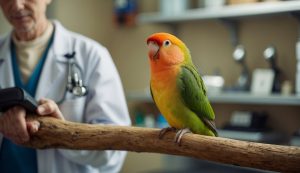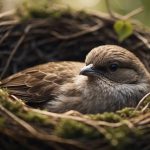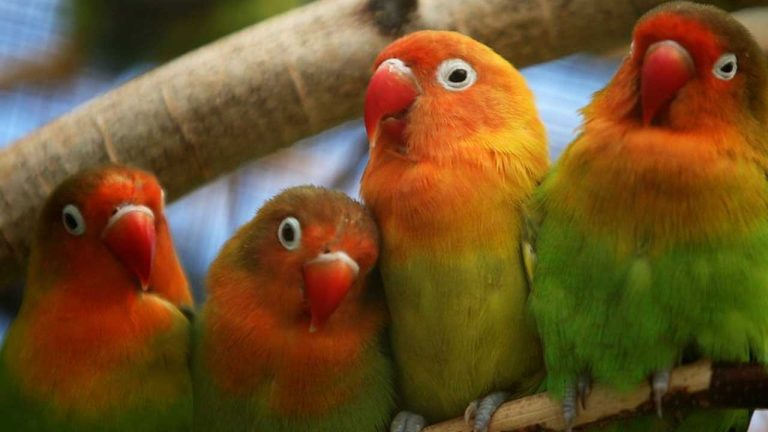Do Lovebirds Need a Mate? Understanding the Social Needs of These Adorable Birds
Lovebirds are known for their affectionate nature and their ability to form strong bonds with their mates.
However, many people wonder if lovebirds need a mate to live a happy and healthy life. The answer is no, lovebirds do not necessarily need a mate to thrive, but they do require proper care and attention from their owners.
Understanding lovebirds is key to providing them with the care they need. Lovebirds are social birds that thrive on interaction and attention. They require plenty of mental and physical stimulation to stay happy and healthy.
While having a mate can provide some of this stimulation, it is not the only way to meet their needs. Providing them with toys, perches, and regular interaction with their owners can also help keep them content.
Key Takeaways
- Lovebirds do not necessarily need a mate to thrive, but they do require proper care and attention.
- Understanding lovebirds and their social nature is key to providing them with the care they need.
- Providing lovebirds with toys, perches, and regular interaction with their owners can help keep them content.
Table of Contents
Understanding Lovebirds
Species and Origin
Lovebirds are small parrots belonging to the genus Agapornis, which is native to Africa and Madagascar. There are nine species of lovebirds, with the most common being the Peach-faced Lovebird and the Black-cheeked Lovebird.
Physical Characteristics
Lovebirds are small in size, typically measuring around 5-7 inches in length. They have a hooked beak, short blunt tail, and colorful feathers. One of the most distinctive features of lovebirds is their eye ring, which is a circle of feathers around their eyes.
Behaviour and Personality Traits
Lovebirds are known for their affectionate behaviour towards their mate and their owners. However, they can also be aggressive and territorial, especially during the breeding season. Lovebirds can become jealous and hormonal, leading to erratic behaviour. They also engage in preening and social stability behaviours.
Diet and Nutrition
Lovebirds have a diet that consists of seeds, vegetables, fruits, and pellets. They also require a calcium supplement to maintain their nutrition and health. It is important to provide a healthy and balanced diet to avoid health issues.
Health and Lifespan
Lovebirds can live up to 15 years with proper care and nutrition. They are prone to depression if they are not given enough attention or social interaction. Regular visits to the vet are necessary to ensure they are healthy.
Housing and Environment
Lovebirds can be kept as pets in cages or aviaries. They require a spacious environment with plenty of toys and perches to keep them entertained. It is important to provide a clean and safe living environment.
Fun Facts
- Lovebirds mate for life and can become depressed if separated from their mate.
- Some species of lovebirds can live together in groups of three.
- Lovebirds are known for their affectionate behavior towards their mate and owners.
Lovebirds and Mating
Lovebirds are known for their affectionate and social nature. They are often kept in pairs, and many owners wonder if their lovebirds need a mate. In this section, we will explore the mating behavior of lovebirds and what you need to know if you are considering breeding them.
The Mating Process
Lovebirds are monogamous and mate for life. The mating process begins with courtship behavior, which can include singing, dancing, and feeding each other. Once the pair has bonded, they will engage in mating rituals, which can involve preening, regurgitating food, and copulation.
Gender and Compatibility
Lovebirds are sexually dimorphic, which means that males and females have different physical characteristics. However, it can be difficult to determine the gender of a lovebird without a DNA test. When it comes to compatibility, it is best to pair a male and female lovebird, as two males or two females may not bond as successfully.
Bonding and Monogamy
Lovebirds form strong bonds with their mates and are monogamous. They will defend their mate from perceived threats and can become jealous if they feel their bond is being threatened. It is important to provide a stable and secure environment for your lovebirds to maintain their bond.
Breeding and Offspring
Lovebirds can start mating between one and two years old. The female will lay eggs in a nesting box, and both parents will take turns incubating them. Lovebirds can lay unfertilized eggs, so it is important to provide a suitable nesting environment to encourage successful breeding.
Nesting and Incubation
Lovebirds require a nesting box to lay their eggs. The box should be made of a non-toxic material and be large enough for the pair to comfortably fit inside. Once the eggs are laid, both parents will take turns incubating them. The eggs will hatch after about 23 days, and the hatchlings will be dependent on their parents for several weeks.
Potential Challenges
Breeding lovebirds can come with challenges, such as aggression towards other birds in the household and potential health issues. It is important to provide a healthy and stable environment for your lovebirds to ensure successful breeding.
In conclusion, lovebirds are social and affectionate birds that mate for life. If you are considering breeding lovebirds, it is important to understand their mating behavior and provide a suitable nesting environment. By providing a stable and secure environment, you can help ensure the success of your bonded pair.
Caring for Lovebird Mates
Lovebirds are social birds that mate for life. While they do not necessarily need a mate to survive, they thrive when they have a companion. As a pet owner, it is your responsibility to provide the best care possible for your lovebird mates. Here are some tips on how to care for your lovebirds.
Feeding and Nutrition
A healthy diet is crucial for the well-being of your lovebirds. In the wild, lovebirds feed on a variety of seeds, fruits, and vegetables. In captivity, it is important to provide a balanced diet that includes fresh fruits, vegetables, and a high-quality seed mix. Calcium is especially important for breeding pairs, as it helps with egg formation and prevents egg binding.
Providing a Suitable Environment
Lovebirds need plenty of space to move around and exercise. A spacious cage with plenty of toys and perches will keep your lovebirds entertained and happy. A nest box is also essential for breeding pairs. Make sure the cage is placed in a quiet area away from any potential hazards, such as other pets or household appliances.
Health Check and Veterinary Care
It is important to keep your lovebirds healthy by providing regular health checks and veterinary care. A veterinarian who specializes in avian medicine can provide routine check-ups, vaccinations, and treatment for any illnesses or injuries. Pregnant lovebirds should be given extra care and attention to ensure a safe and healthy pregnancy.
Maintaining Social Stability
Lovebirds are monogamous and form strong bonds with their mates. It is important to maintain social stability in the flock by keeping pairs together and preventing any aggressive or territorial behavior. Jealous or hormonal behavior can also lead to erratic or aggressive behavior, so it is important to provide plenty of toys and distractions to keep your lovebirds occupied.
Dealing with Behavioral Issues
Lovebirds can exhibit a variety of behavioral issues, including aggression, territorial behavior, and excessive screaming. It is important to address these issues early on to prevent them from escalating. Positive reinforcement, such as treats and praise, can be used to encourage good behavior. It is also important to provide a calm and consistent environment for your lovebirds.
Understanding Lovebird Needs
Lovebirds are social animals that thrive on companionship and interaction. They are vulnerable to stress and depression when they are kept in isolation or in an unsuitable environment. As a pet owner, it is important to understand the needs of your lovebirds and provide a safe and comfortable environment for them to live in.
In conclusion, caring for lovebird mates requires a combination of proper nutrition, a suitable environment, regular health checks, and attention to their social and behavioral needs. By providing the best care possible, you can ensure that your lovebirds live long and healthy lives as happy and content pets.
Conclusion
In conclusion, lovebirds are social birds that thrive on companionship. While they can survive alone, they are happier and healthier when they have a mate. Lovebirds mate for life and remain bonded to each other until one of them dies. When a lovebird loses its partner, it may become depressed and lonely, and its health may suffer as a result.
If you are considering getting a lovebird, it is important to provide it with a suitable mate. Lovebirds that are kept alone may become bored and destructive, and may even develop behavioral problems. A suitable mate will provide your lovebird with the social interaction it needs to thrive.
When introducing a new lovebird to your existing one, it is important to do so gradually. Lovebirds can be territorial and may become aggressive towards a new bird. It is important to keep the birds in separate cages at first and gradually introduce them to each other over time.
In summary, lovebirds are social birds that need companionship to thrive. If you are considering getting a lovebird, it is important to provide it with a suitable mate to ensure its happiness and well-being.
Frequently Asked Questions
How much attention do lovebirds need?
Lovebirds are social birds that require daily interaction and attention from their owners. If you plan to keep a single lovebird, you should be prepared to spend a lot of time with it every day.
If you cannot commit to spending time with your lovebird, it is best to get a pair of lovebirds to keep each other company.
Do lovebirds talk?
Lovebirds are not known for their talking ability like some other parrot species.
But they can learn to mimic some sounds and words with proper training and socialization.
Do lovebirds mate for life?
Yes, lovebirds are monogamous and mate for life. They form strong bonds with their partners and can become depressed if separated from them.
How long do lovebirds live?
Lovebirds have a lifespan of about 10 to 15 years in captivity with proper care and nutrition.
Male lovebird mating behaviour?
Male lovebirds display courtship behaviour by regurgitating and feeding the female. They also bob their heads up and down to bring back food from their crop.
If the female accepts the male’s invitation, they will mate and form a strong bond.
Can lovebirds live without a mate?
While lovebirds are social birds that thrive in pairs or groups, they can live alone with proper socialization and attention from their owners.
Keeping a single lovebird requires a lot of time and attention from the owner. If you cannot commit to spending time with your lovebird, it is best to get a pair of lovebirds to keep each other company.








